How to Jiu Jitsu - Episode 3: The Basic Jiu Jitsu Ground Positions
Episode 3: The Basic Jiu Jitsu Ground Positions
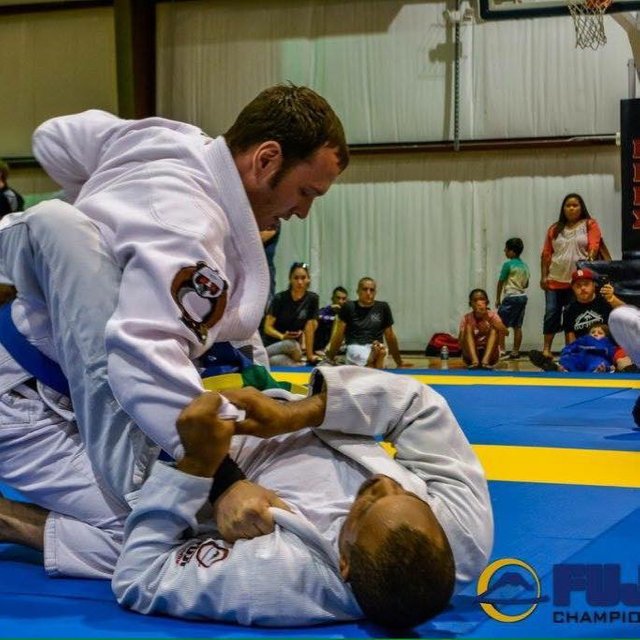
In jiu jitsu you must learn to crawl before you can learn to walk. One of the most common sayings in self-defense or sport jiu jitsu is "position before submission."
According to wikipedia:
Positioning is the foundation of ground fighting, if one combatant is physically clearly on top, such as if they are pinning the other combatant to the ground, then that combatant is said to have the top position, while the other combatant is said to have the bottom position. Top positions are usually dominant as fighters can use their weight to their advantage, but depending on the set of rules used, it can have notable exceptions such as the guard. A dominant ground position is usually easier to obtain for the person who initiated the throw or takedown. It may be possible for a fighter in a dominant position to score points or win by pinning their opponent, applying a Submission hold or striking.
In this episode we will discuss the basic ground positions of jiu jitsu. We will discuss in order of dominance.
Rear Mount Top
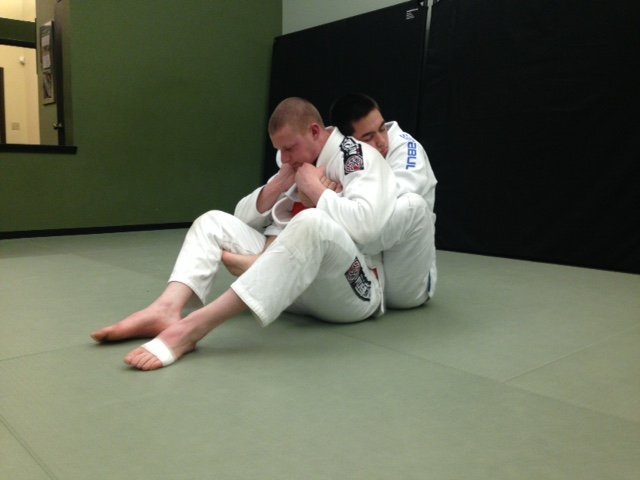
Rear mount is when you have taken your opponents back. You control them from behind by connecting your hands over the shoulder, under-hooked under the armpit, with the hands clasped or controlling the gi collar, and the feet are around the outside of their hips using the hooks. Note: Do not cross your feet, this can lead to a painful submission from your opponent.
This is the most dominant position because not only do you control your opponent, but he is also at a disadvantage from visually seeing what you may be setting up.
https://en.wikipedia.org/wiki/Back_mount
Mount Top
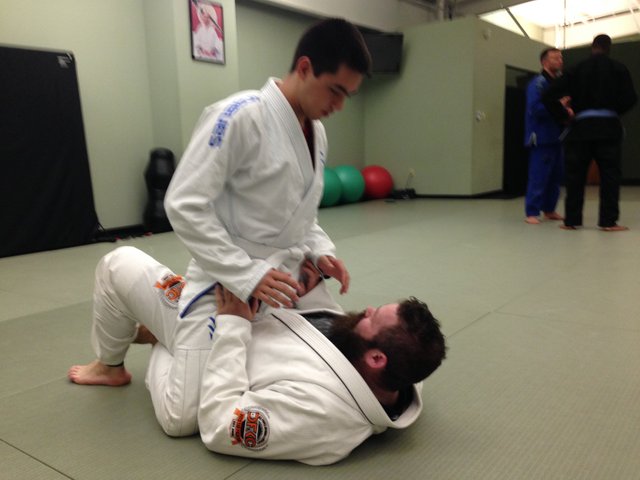
The mount is when you have taken the top position on an opponent who is lying on his back on the ground. You are straddling the hips/waist area with both of your legs/knees on the outside of the oppnents hips. Your feet are tucked in below your opponents butt and between their heels and butt. You can stay upright with posture gaining your base from your shins on the ground. You can also lean forward with both of your forearms or hands on the ground for added base. If you shoot your hips forward combined with shooting your legs up as hooks, you can apply a lot of pressure where the opponent must cary the load of all your weight.
This is a very dominant position for control, striking and setting up positions. This is slightly less dominant from the rear mount due to the danger of your opponent sweeping your base and upgrading their position or even taking a dominant position.
https://en.wikipedia.org/wiki/Mount_(grappling)
Knee on Belly Top
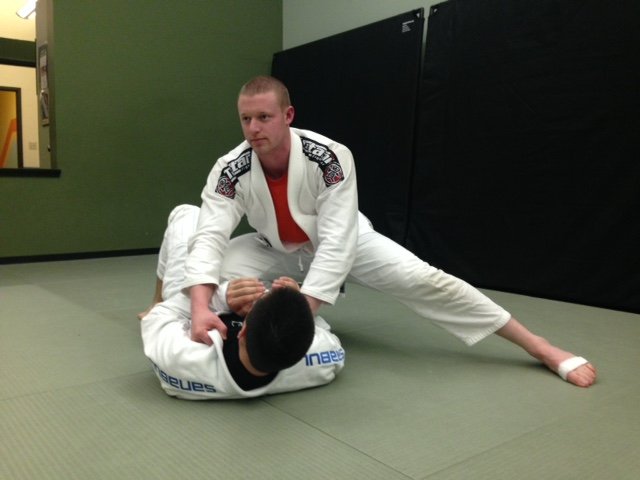
Knee on belly is a modified version of side control that is usually gained after passing the guard or transitioning from another position such as side control. Your hands are pressing on your opponents shoulders, arms, chest or hips for base, sometimes using the gi sleeves or collar for control. Your inside knee/shin is slid across from hip-to-hip or from hip-to-belly or chest. Your outside leg is structured diagonally out in line with the shoulder for base.
This is a very dominant position that applies a lot of control and pressure combined with a structured base. You are at risk for sweeps and submissions from your opponent on the bottom.
https://en.wikipedia.org/wiki/Knee-on-stomach
Side Control Top
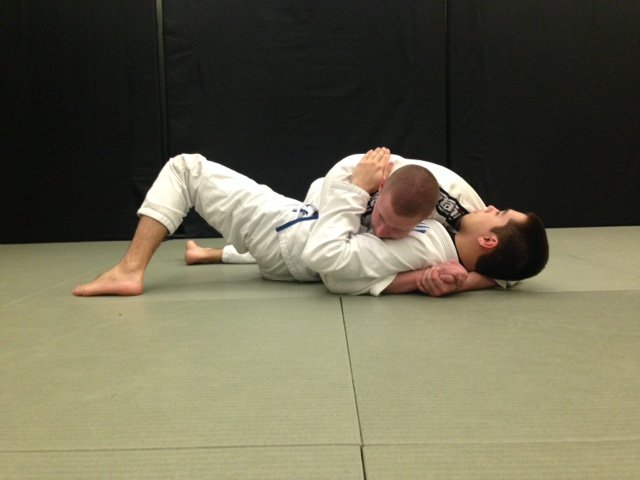
Side control is when you are chest-to-chest and perpendicular to your opponent while they are on their back on the ground. There are different hand, leg and hip configurations.
This is a very dominant position that allows for easy control, transitions and submission setups. You are at risk for sweeps and submissions from the bottom. You also must maintain control from your opponent who is trying to recover half guard or full guard.
https://en.wikipedia.org/wiki/Side_control
Half Guard Top
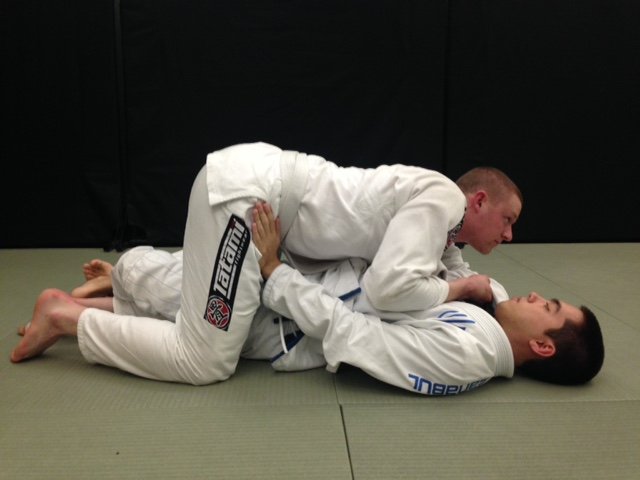
Half guard top is when you are in the top position with your weight on the opponent. One of your legs is on the outside of your opponents hip while they are on their back on the ground. Your other leg is on the inside of both of your opponents legs. They may have trapped your leg with their half-guard for control.
This position is only dominant because you are on top of the opponent. You can use this position as a transition and while it is dominant, it may be more difficult to control your opponent and you are also subject to sweeps and submissions from the bottom defender. You are at risk of your opponent sweeping you, slipping out the side and taking your back, or recovering full guard.
https://en.wikipedia.org/wiki/Half_guard
Guard Top - Guard Bottom
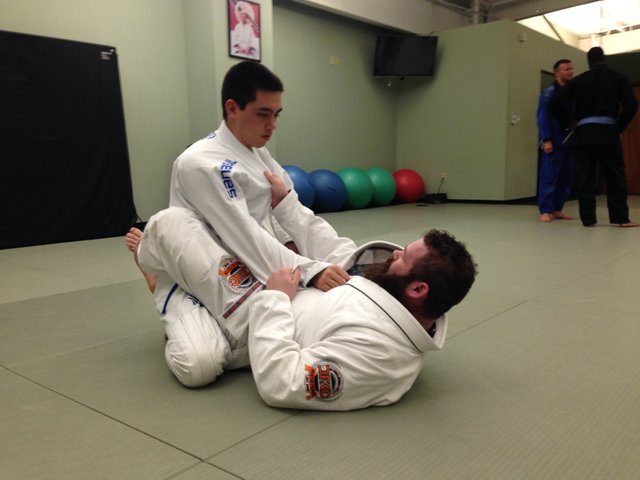
Guard is a position in which one fighter is lying on the ground on their back, controlling their opponent with their legs around the outside of the hip/waist/back. The opponent inside or in top guard position is on their knees and shins. It's preferable that the fighter inside the guard sink their hips and butt back to their heels to maintain good base.
This position is described by some to be neutral, or mistakingly that the fighter in the top position may be in control because they are on top. However, the legs around the hip/waist/back area actually provides a large amount of control over the opponents base that can provide leverage for sweeps. The fighter inside of the guard is limited with the amount of submissions available. Striking can be dangerous from inside the guard because movement of your base to throw strikes may lead to sweeps or submission attempts.
https://en.wikipedia.org/wiki/Guard_(grappling)
Turtle Top - Turtle Bottom
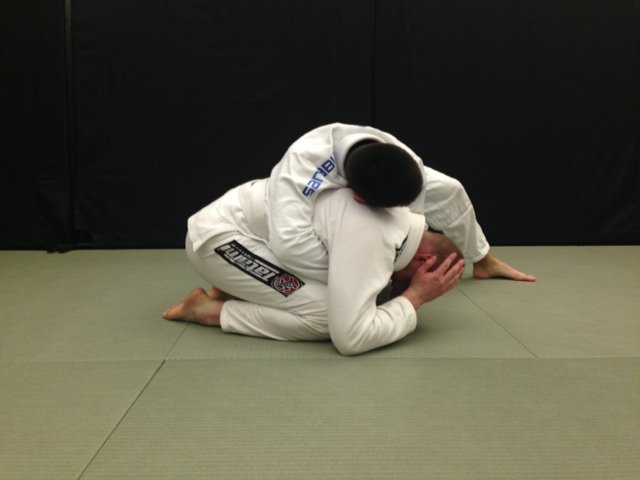
The turtle is a transition position that is usually the result of a scramble or rollout from another position. The fighter on the top position is usually attempting to maintain control on either side or from behind their opponent. There are many different hand position combinations that can be used as well as utilizing the gi top or pants for control. The hand positions may go over the shoulder, around the neck and clasp the opposite hand that under-hooks the opposite armpit. You may also see different variations of control from both arms around the waste. The fighter on bottom in the actual turtle position is on their knees/shins, with their elbows tucked tightly to the inside of the inner thigh/hip area.
The fighter in the bottom position is keeping a defensive strategy of preventing the clasping of the hands and insertion of the feet/heels into their inner thigh/hip area, providing hooks for control over the bottom fighter. The bottom fighter must also be aware of sweeps and submissions from the top fighter. The goal of the bottom fighter should be to defend these attempts and to upgrade their position to guard, half guard, or any other dominant position.
The fighter in the top position can attack with sweeps to a more dominant position or submissions. The entry point may be available to insert the feet as hooks and roll to take control of their opponent's back.
https://en.wikipedia.org/wiki/Turtle_(grappling)
Half Guard Bottom

Half guard bottom is when the fighter is on bottom and controls one leg of the top opponent by wrapping both legs around the inside leg of their opponent. The opponent's second outside leg is free. The fighter on bottom half guard has the ability to sweep or submit their opponent.
This position is not as safe as having the full guard, but if played correctly, sweeps and taking the back are available.
https://en.wikipedia.org/wiki/Half_guard
Side Control Bottom
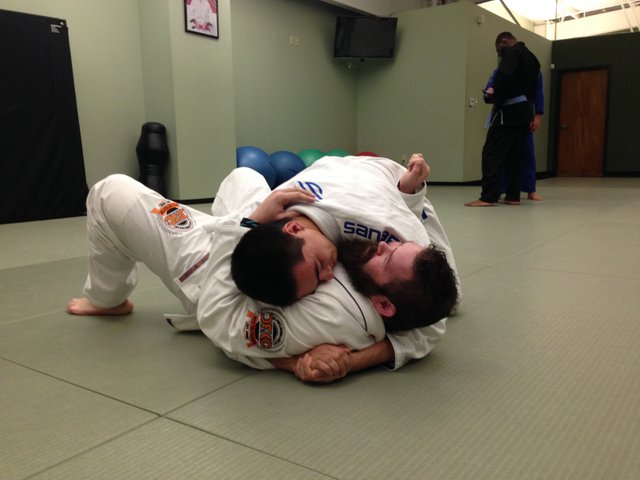
Side control bottom is when the fighter is underneath the perpendicular opponent who is chest to chest for control. The fighter on the bottom must attempt to prevent being flattened out with both shoulders on the mat. The fighter must turn towards their opponent to their inside hip. The inside leg nearest the opponent is usually flat with the foot connected to the floor. The outside leg is up at an angle with the heel near their own butt. There are many variations of arm and leg placement. The basic placement of the arms/hands is the inside forearm is against the opponent's hip and the outside arm is creating a frame against the opponents neck/chin.
This is a very dangerous position from the bottom. You are at risk of being flattened out with both shoulders to the mat. The opponent can transition to many other positions and has many submissions available. You must prevent the opponent from sliding over the top of your hips into the full mount.
https://en.wikipedia.org/wiki/Side_control
Knee on Belly Bottom

Knee on belly bottom is very similar to side control bottom with the exception that the opponent has their knee/shin across your hips and mid-section. You must attempt to prevent many transitions and submissions from this position, including the opponent sliding the knee across to the outside of the far hip for full mount.
This is a very dangerous position from the bottom. However, there is some sacrifice of base from the top fighter since they are disconnected from the ground.
https://en.wikipedia.org/wiki/Knee-on-stomach
Mount Bottom
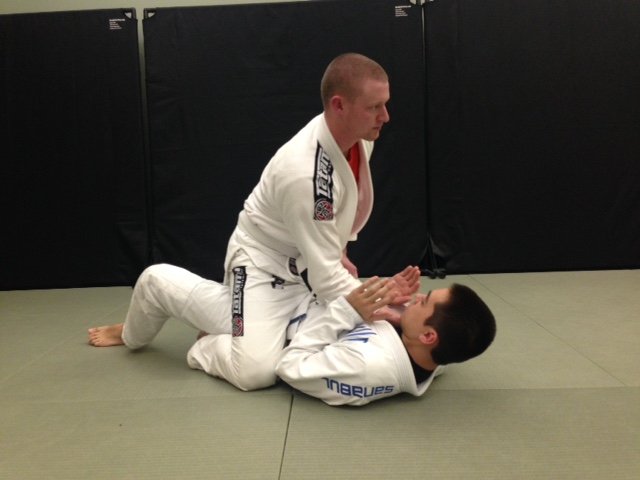
The bottom position of mount is when the fighter is lying on the ground with their opponent on top, straddling the outside of the hips. The fighter in the bottom position is subject to strikes and submissions, as well as transitions to other positions. In order for the fighter to defend themselves from the bottom position, they must keep their elbows tucked in tight to the sides against the top opponent's thighs. They must also use their hands to control the top opponents hip/waste area. This keeps the top opponent from sliding their shins/knees forward towards the bottom fighters armpit/upper chest area. The bottom fighter must also try to gain control over the top opponent by trapping the top opponent's ankle/foot with their own foot by steeping to the outside of the attacker's foot. You must also attempt to switch from controlling the hips to trapping the hand/arm area of the top opponent. There are also other escapes from the bottom that require you to use the same method as escaping side control bottom. You gain the ability to escape the bottom position by switching to one of your hips. You must keep one leg flat and one leg raised with your knee to the top opponent's butt. The bottom opponent must then use the flat leg to scrape underneath the top opponent's instep in the ankle, and clearing to the outside of the top opponent's leg.
This position is at a great disadvantage and leaves the bottom fighter open to strikes and submissions. However, the bottom fighter does have the ability to use these attempts to compromise the top opponent's base and upgrade their position (such as re-gaining half guard or full guard) or even sweep the opponent to a more dominant top position.
https://en.wikipedia.org/wiki/Mount_(grappling)
Rear Mount Bottom
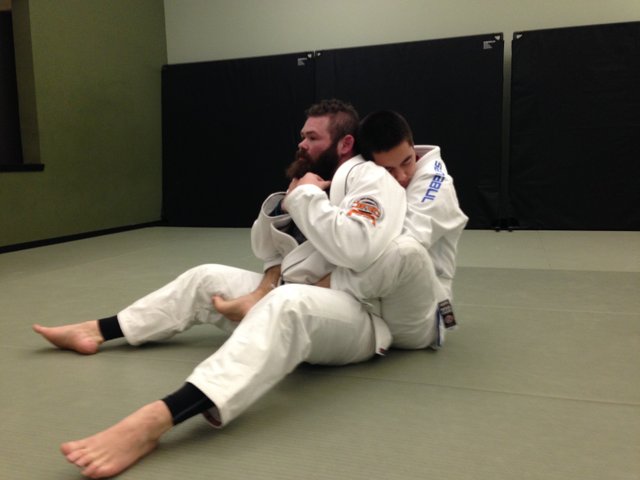
Rear mount bottom position is really when you are inside the rear mount. The fighter usually has control around your shoulder and neck area and may control the gi collar or sleeves. The fighter also usually has both feet inserted as hooks inside of your inner thigh/hip area. You must use both of your hands to control the attacker's arms and hands to prevent many variations of chokes and other submissions from the back. The fighter must also defend the hooks into their own inner thigh/hip area that provides a great amount of control over them.
This is the most dangerous position to be in during a fight. You are at risk of being attacked with both strikes and submissions from behind and you are at a disadvantage to visually see these attacks or any transitions coming.
https://en.wikipedia.org/wiki/Back_mount
In a future episode of How to Jiu Jitsu, I will be submitting videos breaking down each position for both top and bottom (offense and defense). Be on the lookout for the next episode: Top 5 Jiu Jitsu Drills You Can Practice at Home.
If you have any questions, please feel free to comment below. I'd love to hear from you!
@framelalife is a 2 stripe blue belt under Royce Gracie. I train at Three Rivers Martial Arts which is in the Royce Gracie Network. Three Rivers Martial Arts is very lucky to have a large staff of professional instructors including: Jason Hawkins, Eli Knight, Derik Perry, Jim Hemphill, Eric Romanak, Clay Mayfield, and Dustin Lynn. The primary focus of Three Rivers Academy is Brazilian Jiu Jitsu but also includes Jeet Kun Do, Judo, Silat, and Martial Arts Concepts.

Great information. I'm very interested in Jiu Jitsu, but until I drop more weight I'll stick with my yoga. It's super interesting to see though. You should take some videos in class, if you're able to. I'd love to see it in action.
Thanks! Videos are coming soon. They will be a large part of the content for How to Jiu Jitsi :)
Don't wait to lose weight, BJJ will help you drop pounds. I'm a brown belt instructor in New York and I have seen students melt away fat with it. I myself was 280 when I started in 2006 and I'm 200 now.
Look forward to the next one, thanks.
Thanks! I think the following video blogs will be a lot more helpful than the general descriptions in this one. There are so many details that would be lost in written description.